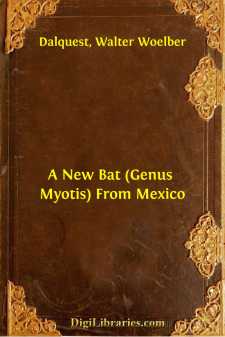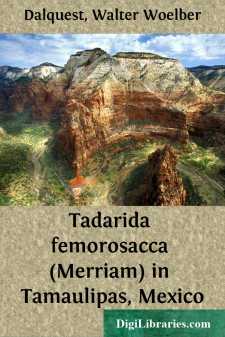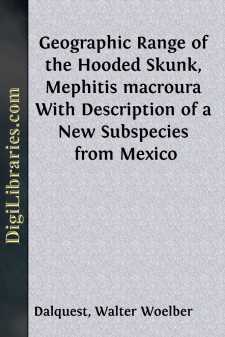Categories
- Antiques & Collectibles 13
- Architecture 36
- Art 48
- Bibles 22
- Biography & Autobiography 813
- Body, Mind & Spirit 142
- Business & Economics 28
- Children's Books 15
- Children's Fiction 12
- Computers 4
- Cooking 94
- Crafts & Hobbies 4
- Drama 346
- Education 46
- Family & Relationships 57
- Fiction 11828
- Games 19
- Gardening 17
- Health & Fitness 34
- History 1377
- House & Home 1
- Humor 147
- Juvenile Fiction 1873
- Juvenile Nonfiction 202
- Language Arts & Disciplines 88
- Law 16
- Literary Collections 686
- Literary Criticism 179
- Mathematics 13
- Medical 41
- Music 40
- Nature 179
- Non-Classifiable 1768
- Performing Arts 7
- Periodicals 1453
- Philosophy 64
- Photography 2
- Poetry 896
- Political Science 203
- Psychology 42
- Reference 154
- Religion 513
- Science 126
- Self-Help 84
- Social Science 81
- Sports & Recreation 34
- Study Aids 3
- Technology & Engineering 59
- Transportation 23
- Travel 463
- True Crime 29
A New Bat (Genus Myotis) From Mexico
Description:
Excerpt
While one of us (Dalquest) was in a dugout canoe that was being paddled up a small unnamed tributary of the Rio Coatzacoalcos, through dense jungle, he grasped a decayed and termite damaged tree-trunk projecting approximately three feet above the surface of the water to steady the canoe. At that instant two bats were detected in one of the many small holes in the trunk, which was eight to nine inches in diameter. It was a simple matter to enlarge the hole and extract the animals. Superficially they resembled silvery-haired bats (Lasionycteris) but their naked interfemoral membranes and other features suggested that they belonged to the genus Myotis. Subsequently, study in the laboratory showed this to be the fact and revealed also that they are of an heretofore unnamed species which may be known as:
Myotis argentatus, new species
Type.—Male, adult, skin with skull, No. 19228, Mus. Nat. Hist., Univ. Kansas; 14 kilometers southwest of Coatzocoalcos, 100 feet elevation, Veracruz, Mexico; 2 February 1947; obtained by Walter W. Dalquest; original No. 7052.
Range.—Known only from the type locality.
Diagnosis.—Size medium for the genus (see measurements), tail short; foot long; ears and membranes black; pelage long (maximum length on middle of back 9 mm.) and black; upper parts with overhairs tipped with whitish especially on rump; underparts from posterior part of thorax posteriorly with all of the hairs tipped with this same whitish color; skull with preorbital part small in relation to brain case; teeth small in relation to total area of palate; brain case much inflated; ventral margin of foramen magnum evenly rounded.
Comparison.—From Myotis albescens (E. Geffroy) known to us by specimens in the United States National Museum from Paraguay (Tacural), Panama (Tabernilla), and Nicaragua (Prinzapolca R. and Escondido R.), argentatus differs in: Body and foot longer; tail relatively shorter (57 and 58% of length of head and body versus 76 (62-83)% in albescens); tibia shorter; pelage longer, and black instead of brown; silver tipping of fur on hinder back markedly more conspicuous; precranial part of skull, when viewed from above, larger in relation to brain case; postorbital constriction less abrupt, that is to say, skull "longer-waisted"; occlusal surfaces of teeth of equal area and therefore occupying a relatively smaller percentage of total area of palatal surface; ventral margin of foramen magnum less deeply indented; ventrally prominent part of basioccipital twice as wide.
Remarks.—The relatively slight wear on the teeth of the female of M. argentatus and the large ends on the bones of the wings indicate that it is immature. Its measurements, recorded below, average smaller than those of the adult holotype, a male, and the silvery tipping on the upper parts is almost lacking from the pelage which is shorter than in the holotype.
Figs. 1-6.Myotis. From left to right, dorsal, lateral and ventral views. All × 2.Figs. 1-3.Myotis argentatus, no. 19228, Univ. Kan. Mus. Nat. Hist., type.
Figs. 4-6.Myotis albescens, no. 105664, [F], U. S. Nat. Mus., from Tacuaral, Paraguay; obtained on November 13, 1900, by Wm. T. Foster, orig. no. 128.
Among at least American kinds of Myotis, argentatus is extreme in small area of occlusal surface of the upper molariform teeth in relation to the total area of the palatal surface of the skull. M. albescens previously was regarded as extreme in this feature. The distance across the third upper molars, from the outside of one tooth to the outside of the other, is 5.5 mm. in the holotype of argentatus and 5.4 mm. in a specimen of corresponding age and sex of albescens. The distance between the third upper molars, from the lingual side of one tooth to the lingual side of the other, is 2.9 mm. in argentatus and 2.8 mm....






